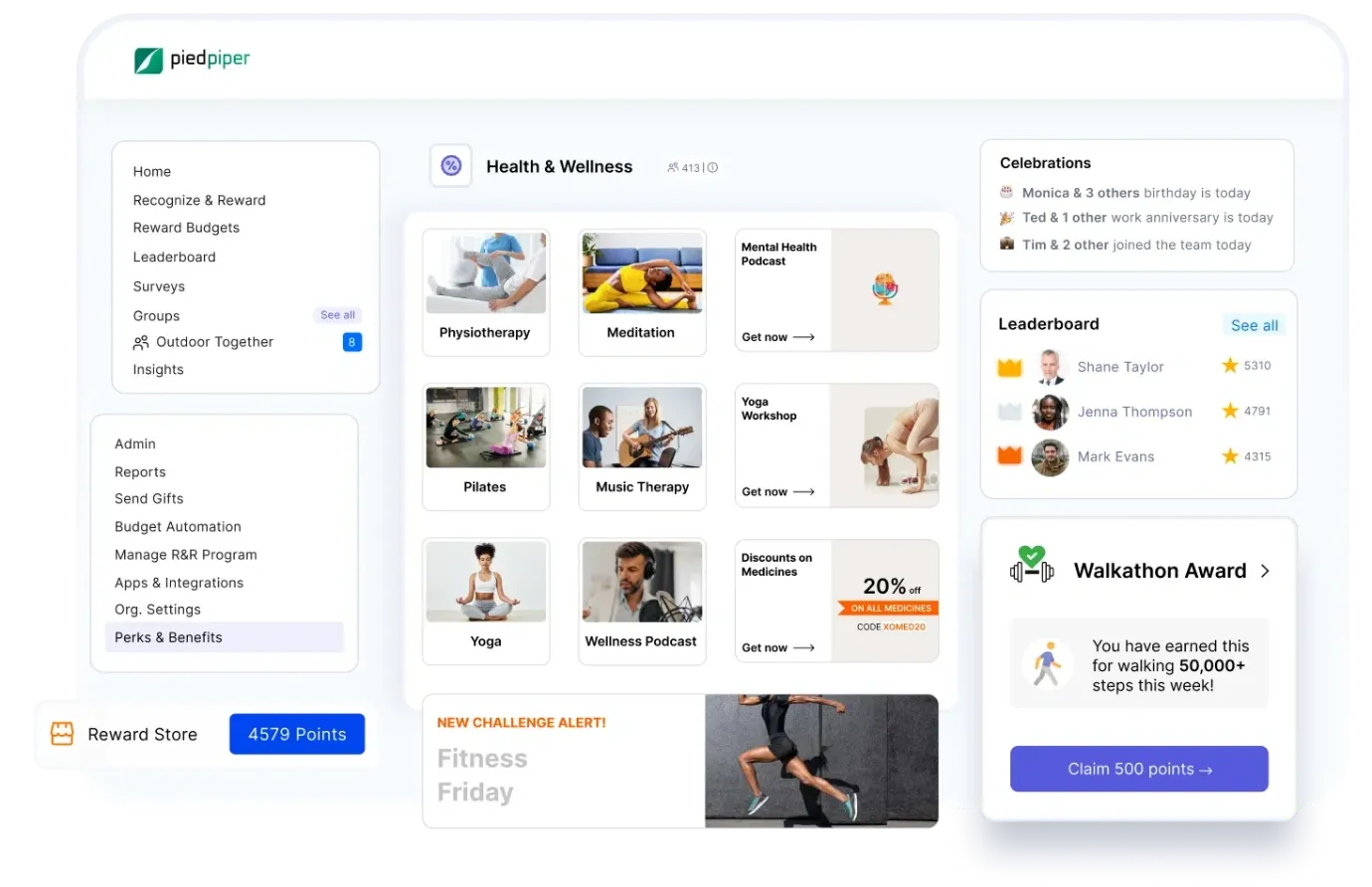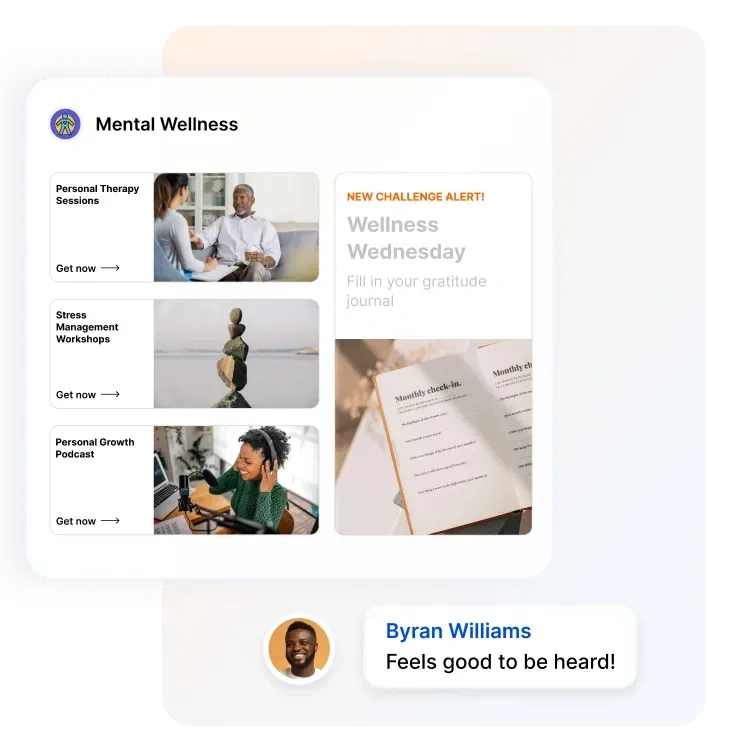The Ultimate Guide to Building an Effective Employee Wellbeing Program
An employee wellbeing program enhances productivity, engagement, and retention. Learn how to create a workplace culture that prioritizes employee well-being and success.
On this page
- Understanding employee wellbeing programs
- The benefits of employee wellbeing programs
- Factors affecting employee wellbeing
- How not to establish a workplace wellbeing program?
- Then how do you create effective employee wellbeing programs?
- Top 8 employee wellbeing programs to implement in 2025
- How Empuls enhances employee wellbeing programs
- Conclusion
Every business wants its employees to be happy and healthy. That’s why so many small businesses and large corporations these days are starting to think about how they can contribute to employee health and wellness.
Since people spend so much of their lives at work, this is a very vital concern for employers.
And focusing on employee mental health and wellbeing at work isn’t just something that feels nice to provide - it’s actually beneficial for many areas of your business.
So if you want to keep your best employees and help them do great work, you need to focus on improving employee well-being. But let’s be honest - there are plenty of poorly designed health and wellbeing programs for employees out there.
So how can you be sure you’re creating one that your employees will actually thank you for? After all, workplace wellbeing programs only work well when employees participate often and enthusiastically.
No need to fear - we’re here to guide you through everything you need to know about creating a wellbeing program your employees will love.
Let’s get started!
Understanding employee wellbeing programs
Employee wellbeing programs focus on improving the physical health of employees at your company.
They look a little different at every organization, but many of them include features like smoking cessation programs, gym membership discounts, healthy office snacks, step competitions, and more.
Many wellbeing programs are also now beginning to focus on mental health as well as physical. By implementing programs like EAP (Employee Assistance Programs), stress reduction programs, meditation programs, and more.
It’s all about improving employee health by making it easier and cheaper to live a healthy lifestyle.
The benefits of employee wellbeing programs
Why do employers invest in these programs? They can be fairly costly, depending on which programs your organization picks.
But despite the cost and the effort needed to implement them, they’re often very effective and have a big return on investment.
That’s because happy, healthy employees are much more productive and engaged than employees who are tired, stressed, worried, or sick.
On a basic level, keeping employees healthy means they don’t miss work as often, and that’s obviously great for the success of your business. Plus, rapidly rising healthcare costs in places like the US mean employees getting sick can be a huge drain on company resources.
But being productive and engaged means employees need to have lower levels of worry and stress in their lives too, and many more advanced employee wellbeing programs address that as well.
The World Health Organization says that mental illness is now the leading cause of disability and illness. High levels of chronic stress caused by unhealthy workplace cultures have a real impact on employee engagement and productivity.
No one does their best work when surrounded by stressful conditions. But as sad as that sounds, well-designed employee health and wellness programs can help alleviate many of those problems.
Not only will your employees be healthier and more productive, but they’ll also feel supported and happier to work at an organization that takes such thoughtful care of them. That means less turnover and higher job satisfaction too!
Factors affecting employee wellbeing
Three essential factors increase employee health and wellbeing at work, and we’ll cover them all in-depth today, so you know exactly what you need to do to have happier, healthier, more productive employees.
1. Job control
One of the biggest factors in employee well-being (and employee engagement) is their discretion over what they do and how they do it. That’s the basis of job control.
Limited job control is linked strongly with poorer physical health, including higher death rates, heart disease, and diabetes.
Job control is also an important factor in mental health. Multiple studies have found that people with higher levels of job control have less anxiety and depression.
These findings mean that even though higher-level workers tend to do more stressful tasks, have more responsibilities, and often work long hours, they have fewer negative health effects from their careers because they have higher levels of job control.
It might seem fairly challenging to increase job control for lower-level workers who are mostly responsible for repetitive, boring tasks where they lack control. But it just takes some imagination to look at a new way to increase job control.
For example, reducing the amount of micromanaging that leaders and managers do is a great first step. While managers certainly need to manage their people, getting too into the details and controlling employees is unhelpful for everyone.
If you’re hiring the right people, you really should be letting them do the jobs they were hired to do with the skills they have and not watching their every move. And even workers infamously tightly controlled phone lines can be given additional autonomy with some creative thinking.
Collective Health empowered its “patient advocates” who answer phones to solve complex patient problems to solve problems on the floor as they come up, instead of giving them a strict script.
This has increased employee retention, satisfaction, and motivation. And it’s proved more efficient at solving customer problems as well - everybody benefits.
2. Motivating employees
Job control doesn’t just affect physical and mental health - it also has a strong impact on how motivated and engaged employees are in their jobs. When employees work in an environment where they don’t have much control over their work or how they get it done, it creates stress and uncertainty.
They might be forced to follow ineffective or outdated procedures and then punished for poor results or have goals set for them that are impossible to achieve in their roles.
When this happens, it’s hard for any employee to stay committed to going above and beyond. When you don’t feel you have ownership of your tasks, it decreases competence and accomplishment.
That’s not a workplace that encourages you to try your best because it probably won’t be recognized or rewarded if you do. Low job control makes workplaces feel chaotic and unpredictable - you don’t have control over your role or tasks, so it’s hard to predict your actions' outcomes. That is a pretty significant demotivator for most employees.
3. Social support
Having friends and a strong social network is highly beneficial for health and helps decrease stress, including workplace stress. But in many companies, life in the workplace actually decreases feelings of social support and connection.
Sound surprising? It’s not when you consider the environment at many top businesses. Many workplaces have performance measures that pit workers against each other - like forced curve ranking or promotion systems. Only a specific number of employees are eligible in each review cycle.
Other businesses treat employees like they’re in a purely transactional relationship, where work is exchanged only for money.
4. The right employee wellbeing framework
When most employers think of an employee wellbeing program, they focus on getting employees to take part in healthier individual behaviors on their own. This could mean quitting smoking, drinking less, exercising more, or eating healthier.
Employers typically put these programs in place not to focus on employee needs but to bring down their own healthcare costs. That’s the wrong employee wellbeing framework to use.
The drivers of unhappy and unhealthy employees are more often factors in the control of employers - unfair workplace practices, unmanageable workloads, lack of role clarity, poor communication, and not enough time to get work done.
While getting more exercise and meditating can certainly reduce stress symptoms, if your employee wellbeing program doesn’t address the root causes of that stress, you’re not going to solve the problem with a gym discount.
Giving people reasonable workloads and a sense of fairness at work will go a much longer way to reducing stress-related healthcare costs.
Employees also want more than just a gym discount to care for their health - especially if they’re too tired or burnt out from work actually to make it to the gym every day.
5. Improving employee wellbeing
Employee wellbeing is more than just a nice-to-have. It’s vital to the health of the human beings who work for you, and it’s also a positive business driver.
Employees who are free from high levels of workplace stress and burnout have control over their tasks, and strong social connections at work are more productive and engaged.
Wondering how further to promote that link between employee wellbeing and performance? You can simply ask your employees how they’re regularly feeling to learn how to handle stress at your workplace and what they really want from wellbeing programs. Let’s discuss about employee wellbeing programs.
How not to establish a workplace wellbeing program?
While these benefits are all possible if you pick the right wellbeing programs, they go out the window if you select the wrong one. What does that mean?
Isn’t anything that is meant to help your employees be healthy a good choice? Won’t they be grateful?
Well, not always. You’ve probably done your work well and hired some really smart people - they’ll see through efforts that benefit your company more than them.
If your wellbeing programs are mostly designed to lower insurance premiums by punishing employees for unhealthy behaviors, they’re not going to be happy - and they’re not going to participate as actively as you might like.
As Deloitte has found, there’s actually often a huge gap between what employers think their people need, and what employees actually want. That’s why doing your research properly is vital before you commit to an expensive and unpopular wellbeing program.
And SHRM notes that focusing exclusively on physical wellness is pretty ineffective for most organizations, so it’s better to think holistically about wellbeing.
Then how do you create effective employee wellbeing programs?
Creating a wellbeing program that truly resonates with employees requires more than good intentions—it demands research, personalization, and employee input. Here’s how to do it right:
1. Start with listening: ask, don’t assume
Instead of making assumptions, directly involve employees in the design process:
- Use surveys to understand what employees value most in wellbeing support.
- Ask about stressors, preferred perks, and areas needing improvement.
Tools like Empuls offer lifecycle, eNPS, and pulse surveys with AI-driven insights to uncover employee needs and track sentiment over time.
2. Identify root causes, not just symptoms
Don’t just encourage healthier habits—address systemic workplace stressors:
- Evaluate workloads, fairness, communication gaps, and leadership quality.
- Prioritize job control, autonomy, and social support, which research shows are core to wellbeing.
- Recognize that burnout isn’t solved with a gym pass—it requires structural fixes.
3. Design holistic, flexible programs
Include a variety of initiatives that support:
- Physical wellness: fitness benefits, step challenges, health screenings.
- Mental wellness: therapy sessions, meditation apps, stress management workshops.
- Financial wellness: salary advance programs, tax-saving perks, early wage access.
- Lifestyle needs remote work support, childcare, and learning allowances.
Empuls offers all of the above via customizable Lifestyle Spending Accounts (LSA) and fringe benefits across 50+ countries.
4. Ensure inclusivity & personalization
Avoid one-size-fits-all approaches. Offer choice and flexibility in benefits—e.g., wellness options, rewards, and discounts that reflect different life stages and preferences.
Empuls enables modular configuration of wellbeing programs based on roles, locations, and demographics.
5. Communicate transparently
Even the best program fails without awareness. Ensure clear communication on what's offered and how to access it.
Use internal communication platforms like Empuls Social Intranet to drive awareness, updates, and engagement.
6. Automate for consistency & scale
Automate key touchpoints like:
- Birthday wishes, service anniversaries, wellness nudges, and rewards
- Personalized milestone recognitions to show continuous care
Empuls supports automated workflows and AI nudges to streamline delivery and ensure no moment is missed.
7. Measure impact & iterate
Track participation, sentiment, and ROI:
- Use analytics dashboards to identify what’s working and what’s not.
- Iterate based on continuous feedback to improve adoption and effectiveness.
Empuls provides real-time reporting and people analytics to measure program performance and engagement levels.
By co-creating programs with employees, aligning with their actual needs, and leveraging platforms like Empuls for automation, insights, and personalization, your wellbeing initiatives will be not only effective—but genuinely appreciated.
Top 8 employee wellbeing programs to implement in 2025
Now that you know the perks - and the pitfalls - of employee wellbeing programs, which ones should you actually consider?
Here are a few of the best wellbeing programs that your employees will actually thank you for implementing. These aren’t just our ideas - they’re backed by what employees across the world really want (but don’t forget to check with your own employees too!).
1. Flexible work schedules
This might not strike you as a well-being benefit - but truly, employees are happier and healthier when they have more control over where and when they work.
With so many options for designing flexible work schedules that work for your business, you can provide flexibility and autonomy for your employees so they better balance their work and life together. In fact, Harvard Business Review says that employees thrive when they’re offered these options.
2. Healthy office snacks
Many employers think they’re doing a great service to employees by providing cookies and candy for people to snack on in the workplace. While this might be satisfying in the short term, employees actually want more healthy options provided.
Google provides low-cost healthy snacking options in all of its offices, which employees love. And healthy snacks prevent the mid-afternoon sugar crash from sapping productivity out of your employees too.
3. Wellness counseling
Being healthy and well can be challenging in our fast-paced, fast-food-filled world. Employees who want to be healthy might find it hard to know exactly what steps to take.
That’s why wellness counseling has become so popular as a workplace wellbeing program - employees can get custom guidance and help to live healthier lives on their own terms.
4. Mental health counseling
Getting help when your mental health suffers is often difficult in many places. But poor mental health can lead to serious problems in both work and personal life.
Helping your employees access mental health counseling is both very popular with employees and also a compassionate thing to do - so it’s a great idea to think about how this is something you could offer.
5. Parental support
Being a working parent is hard for both mothers and fathers. It can be a big challenge to balance work and childcare every day. In fact, US employers lose about $13 billion a year due to lost productivity and earnings due to inadequate childcare.
Offering support, like generous paid parental leave, childcare supplements, back-up childcare options, and more can make a big difference in the lives of the parents who work for you, and they tend to be very loyal employees in response.
6. Destressing programs
Workplace stress is a large and growing issue at many - maybe even most - companies. Even if you’ve made significant efforts to create a healthy and supportive workplace culture, stress can still creep in at times during busy seasons or around big projects.
Managing that stress can be hard alone, so implementing programs that help employees learn how to deal with stress can be a big benefit. This could be yoga classes, tai chi, meditation lessons, or other relaxation techniques - Wegman’s offers customized yoga plans for employees, for example.
7. Community involvement
It’s true - employees really value being able to contribute to their communities! Giving them paid time off to volunteer or organizing volunteer days with your teams go a long way to making your employees feel happy and supported.
Plus, it benefits the larger community and the image of your business as well. Liberty Mutual Insurance offers annual days of service called Serve with Liberty, which half of their employees across the globe participate in.
How Empuls enhances employee wellbeing programs

Empuls helps organizations design effective employee wellness programs by addressing both physical and mental well-being. With a data-driven approach, it enables HR teams to build workplace wellbeing programs that employees appreciate and actively engage with.
1. Physical wellness: Supporting a healthier workforce

Empuls promotes employee wellbeing by offering flexible options for physical health, allowing employees to choose what suits them best. From fitness challenges with rewards to gym memberships, virtual yoga classes, and nutrition consultations, employees can access a variety of wellness resources that align with their personal health goals. With Empuls, you get:
- Fitness challenges, gym memberships, and yoga classes
- Mental wellness tools: stress management workshops, therapy sessions, meditation apps
- Flexible fringe benefits: Lifestyle Spending Accounts (LSA) for health, travel, meals, learning
2. Mental wellness: Reducing stress and improving focus

To help employees manage stress, Empuls integrates mental wellness solutions into employee wellbeing programs. Companies can offer personal therapy sessions, stress management workshops, and meditation app subscriptions to help employees improve sleep, breathing, and overall mental resilience.
3. Comprehensive benefits for both employees and employers
For HR teams: Fully customizable to fit company-wide workplace wellbeing programs. Scalable across locations and available on all devices. A robust reporting suite with 24/7 access to data-backed insights and actionable recommendations.
For employees: Holistic support across personal, financial, physical, and mental wellness. Exclusive discounts and extended coverage beyond standard insurance. 24/7 customer support, including multilingual assistance, chat support, and a help center.
By leveraging Empuls’ employee wellness solutions, businesses can create a culture that prioritizes employee wellbeing, enhances engagement, and reduces workplace stress, leading to a happier and more productive workforce. Schedule a call now!
Conclusion
Creating an effective employee wellbeing program isn’t just a checkbox exercise—it’s a strategic investment in your company’s most valuable asset: your people. When employees feel physically healthy, mentally supported, financially secure, and socially connected, they bring their best selves to work. The result? A thriving workplace culture, lower attrition, and higher performance across the board.
But getting wellbeing right requires more than good intentions—it demands the right tools, data, and flexibility to meet the diverse needs of your workforce.
That’s where Empuls makes a real difference.
Empuls helps you design, manage, and scale impactful wellbeing initiatives with an AI-powered, data-backed platform that’s loved by both HR leaders and employees alike. From flexible benefits and mental health resources to global perks and continuous feedback loops, Empuls empowers you to build a culture where everyone can do their best work—and feel great while doing it.
Ready to create a workplace your employees won't want to leave? Start your journey with Empuls today. Schedule a call now!


















